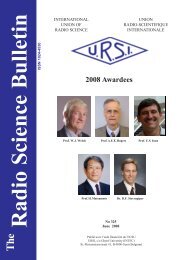Radio Science Bulletin 313 - June 2005 - URSI
Radio Science Bulletin 313 - June 2005 - URSI
Radio Science Bulletin 313 - June 2005 - URSI
- No tags were found...
You also want an ePaper? Increase the reach of your titles
YUMPU automatically turns print PDFs into web optimized ePapers that Google loves.
Figure 20. Theoretical gain ofUCIRA-2.One of our greatest challenges on this project has beenthe construction of the reflector so that it accurately maintainsthe desired hyperbolic shape. A considerable amount ofdispersion results when the path lengths of various rays varyover the surface of the reflector. It is difficult to keep theweight of the antenna minimal, keep the force required toopen the antenna reasonable and still have the stays strongenough to support the fabric reflector in the correct shape.It is also difficult to accurately sew the fabric. Otherconstruction methods and materials may be available, butfor this mechanical deployment scheme a very flexiblematerial such as the conductive rip-stop nylon is required.Thin plastic sheets would probably have a tendency to crackand/or tear during deployment or not lie flat after deployment.Measurements of the antenna patterns for bothchannels in the E and H planes show that the beamwidth inboth planes is approximately 12° - 14°. This is approximatelythe same beamwidth obtained in the standard configuration.This is not surprising since the reflector has not changed. Asmentioned before, the design beamwidth was 20° so we aresomewhat disappointed with this result.By comparing Figure 19 with Figure 16, we see thatthe gain of the antenna in the dual polarity mode is about 2-3 dB less than it is in the standard single feed mode. Thisrelatively small loss, due largely to the impedance mismatchat the feed point, is a small price to pay for adding the dualpolarity capability to the antenna.7. ConclusionsWe built three versions of the Ultra-Compact ImpulseRadiating Antenna, or UCIRA, which was intended forspace applications. The first version, the UCIRA-1, hadelectrical performance that was only slightly less than thatof our commercial CIRA-2. This was a remarkable result,because the UCIRA-1 had a twinline feed instead of thecoaxial cable feed in the CIRA-2. In its collapsed position,the UCIRA-1 was smaller than our commercial CIRA, buta manual operation was required to deploy it. In the UCIRA-1B, we attempted to improve the boresight gain by removingthe negatively contributing portion of the reflector. Thisresulted in performance that was less than that of theUCIRA-1, because the reflector shape came out worse thanbefore.In the final version of the UCIRA, the UCIRA-2, weintroduced a number of improvements. We incorporated anautomatic deployment mechanism, we defocused theaperture to broaden the beam, we allowed for dualpolarization, and we used materials that could be qualifiedfor space operation. Since the feed arms were positioned atequal 90-degree increments around the edge of the reflector,we could feed the antenna either as a single-polarizationantenna with good impedance match, or as a dualpolarization, dual channel antenna with a 2:1 impedancemismatch. When configured as a single-polarization antenna,the gain was considerably less than that of our commercialCIRA-2, because the reflector was defocused into ahyperboloid. When configured as a dual channel antenna,each channel performed well only up to 4-5 GHz, which issufficient for many applications.After studying the various materials that could beused in space applications, the materials used in the UCIRA-2 were very similar to or the same as those used for earliercollapsible antennas. We found a better conductive fabricfor the reflector, and we found that nylon should be asatisfactory fabric for this application. The Tuframâ surfacetreatment on the aluminum was a big improvement. Thisprocess forms a heavy aluminum oxide coating on thealuminum and then a polymer is infused into the surface toform a self-lubricating surface.The development of the balun/twinline feed was amajor success, since the feed for a deployable antenna mustbe very flexible. The attenuation measured for this type offeed was low enough over the frequencies of interest that itcould be used for the satellite application considered here.The<strong>Radio</strong> <strong>Science</strong> <strong>Bulletin</strong> No <strong>313</strong> (<strong>June</strong>, <strong>2005</strong>) 47
















